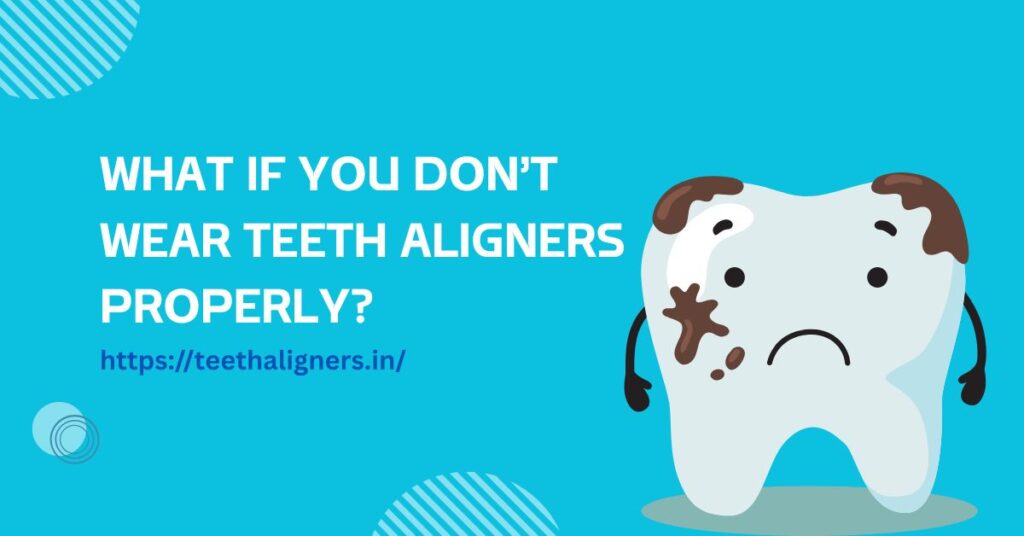Many people are drawn to the comfort and invisibility of clear aligners. They’re modern, removable, and easier to wear than metal braces.
But there’s something most people don’t realise: aligners only work when worn correctly. Skipping even a few hours can slow down your treatment and reduce your final results.
Aligners might seem simple, but your results depend heavily on how disciplined you are. If you don’t follow the instructions, your teeth may shift in the wrong direction, and your treatment time could double. So, what really happens if you don’t wear your aligners the right way?
Table of Contents
ToggleWhy Proper Aligner Use Matters
Teeth Aligners Work Only When Worn
Clear aligners straighten your teeth by applying gentle, steady pressure. That pressure only works when the trays are actually in your mouth.
If you leave them in their case too long, your teeth won’t move—and might even start shifting back to their old positions.
For Plastic Teeth Straighteners to work properly, most dentists recommend wearing them for 20 to 22 hours every day.
This means you should only take them out while eating, drinking anything besides water, brushing your teeth, or cleaning the aligners.
If they’re left out for longer periods, the force needed to guide your teeth is lost, and your progress stalls.
It’s like hitting pause on your treatment every time you remove the trays. Consistency is key to getting the results you want on time.
The Risk of Slower Progress
People often think that missing a few hours here and there won’t matter much. But over time, those missed hours add up.
Wearing your aligners for just 18 hours a day instead of 22 means losing 28 hours of treatment time every week. That’s more than a full day.
When aligners aren’t worn consistently, your teeth don’t move as planned. You may have to wear your current trays longer or even go back to older ones.
In some cases, the treatment timeline extends by weeks or even months.
That delay can be discouraging, especially if you were hoping for a straighter smile by a specific date, like a wedding or graduation.
Common Mistakes Patients Make
Taking Aligners Out Too Often
One of the most common mistakes is removing the aligners too frequently. People often take them out for meals, snacks, phone calls, or meetings—and then forget to put them back in right away. Even short breaks can impact your results.
Let’s say you remove your aligners during lunch and don’t wear them again until the evening. That means you’ve gone hours without any tooth movement.
Do this repeatedly, and your aligners won’t fit properly when it’s time to switch to the next set. Your teeth may lag behind, causing discomfort and slowing down the whole process.
Not Switching Trays as Directed
Each aligner tray is designed to move your teeth slightly from one position to the next. Most treatment plans require you to switch trays every 7 to 14 days.
But if you delay switching trays—or switch too soon without proper movement—you risk losing progress.
Skipping ahead too quickly can make your teeth sore and misaligned, while sticking to one tray for too long can halt movement. It’s important to follow your dentist’s instructions and not guess your own timeline.
If you fall behind, your dentist might need to rescan your teeth or adjust your plan, leading to more visits and a longer treatment overall.
Wearing Dirty or Damaged Aligners
Your aligners should always be clean and intact. Wearing trays that are dirty or damaged can harm your teeth and gums.
Cracks in the plastic can weaken the pressure, making them less effective. Cloudy, stained aligners can hold onto bacteria and smell bad.
In humid regions like parts of India, aligners need extra care. The warm climate can increase bacterial growth, especially if trays are not cleaned regularly.
Rinse them with lukewarm water—not hot—and use a soft brush to clean them daily. Replace any trays that are cracked, warped, or no longer fit properly.
What Happens to Your Teeth and Treatment Timeline?
Teeth May Shift Backward
When you don’t wear your aligners as directed, your teeth can start to move back to their old positions.
This process is called regression. Because your teeth are still adapting to their new places, they need constant pressure to stay aligned. Without that pressure, they shift backward—undoing weeks of progress.
There was a teenager in Pune who wore his aligners for only 14 to 16 hours a day. After three months, his dentist noticed that his front teeth had slightly relapsed.
As a result, he had to go back to a previous tray and restart several steps. What could have been a six-month treatment extended to almost nine months.
You Might Need Refinement Trays
When your teeth don’t move as expected, dentists often provide what are called “refinement trays.”
These are extra aligners designed to correct missed movements or gaps that still remain after the main treatment.
They’re useful, but they often become necessary because the original aligners weren’t used correctly.
Refinement trays may add weeks—or even months—to your treatment. And in some cases, patients may need a whole new set of aligners. That’s not just more time; it can also mean additional costs and extra dental appointments.
Your Oral Health Can Also Suffer

Bacteria Can Build Up
Aligners cover your teeth and gums closely, which can trap bacteria if not cleaned properly. If you wear your trays without brushing your teeth after meals—or if you skip cleaning the aligners—you risk creating a space where bacteria can thrive. This can lead to bad breath, tooth decay, and plaque buildup.
Especially in India, where the warm climate can cause your mouth to dry out faster, it’s important to rinse your mouth and trays after every meal.
Neglecting this step can quickly lead to poor hygiene inside your aligners. You’re not just straightening teeth—you’re creating an environment that needs to stay clean.
Gums May Get Inflamed
Your gums also react to how well you maintain your aligners. If bacteria builds up along the gum line, your gums can become red, swollen, or even start to bleed.
This is a sign of inflammation—and if left untreated, it can lead to gum disease.
Wearing dirty aligners or leaving trays in too long without cleaning can make these symptoms worse.
Regular brushing, flossing, and rinsing—along with proper aligner hygiene—helps protect your gums during treatment.
Healthy gums are essential because they support the movement of your teeth and the stability of your bite.
Tips to Stay on Track with Aligner Wear
Set Reminders or Use Apps
One easy way to stay on track is by using apps or reminders. Several apps let you track how many hours you’ve worn your trays each day, send alerts when it’s time to switch trays, or remind you to clean them. Some even show progress photos to keep you motivated.
If you don’t want to use an app, set phone alarms or calendar events. This simple step helps you build a routine, so you’re not accidentally missing hours or forgetting to wear them altogether.
Travel or Busy Schedule? Carry a Case
Being prepared can make a big difference in how well your aligner treatment goes. A college student using Teeth Aligners in India shared her routine—she always kept a small aligner case, a travel-sized toothbrush, and a rinse bottle in her bag.
This simple setup helped her stay consistent with her treatment, no matter where she was.
Whether she was in class, at the library, or commuting on a crowded train, she could quickly remove or clean her aligners without any stress.
Carrying a case meant she never had to place her trays in a pocket, bag, or on a table—places that can easily collect dirt and germs.
Having your essentials with you not only keeps things hygienic, but also helps you stick to the recommended wear time of 20 to 22 hours a day.
Skipping fewer hours means your aligners stay on track, your treatment stays smooth, and you get the results you’re hoping for without unnecessary delays. Planning ahead really pays off.
Conclusion
Wearing aligners properly isn’t just about following instructions—it’s about protecting your smile, saving time, and getting the results you want.
Not wearing your aligners as directed can lead to longer treatment, extra trays, oral health problems, and more trips to the dentist.
By committing to 20 to 22 hours of daily wear, cleaning your trays regularly, and following your switch schedule, you’re setting yourself up for success.
If you’re already using aligners or planning to get them soon, now you know how important it is to stay consistent.Take the process seriously, trust your treatment plan, and stay on track.
A confident, straighter smile is worth the effort—with support from Teeth Aligners in India, you’re never alone on your journey.

